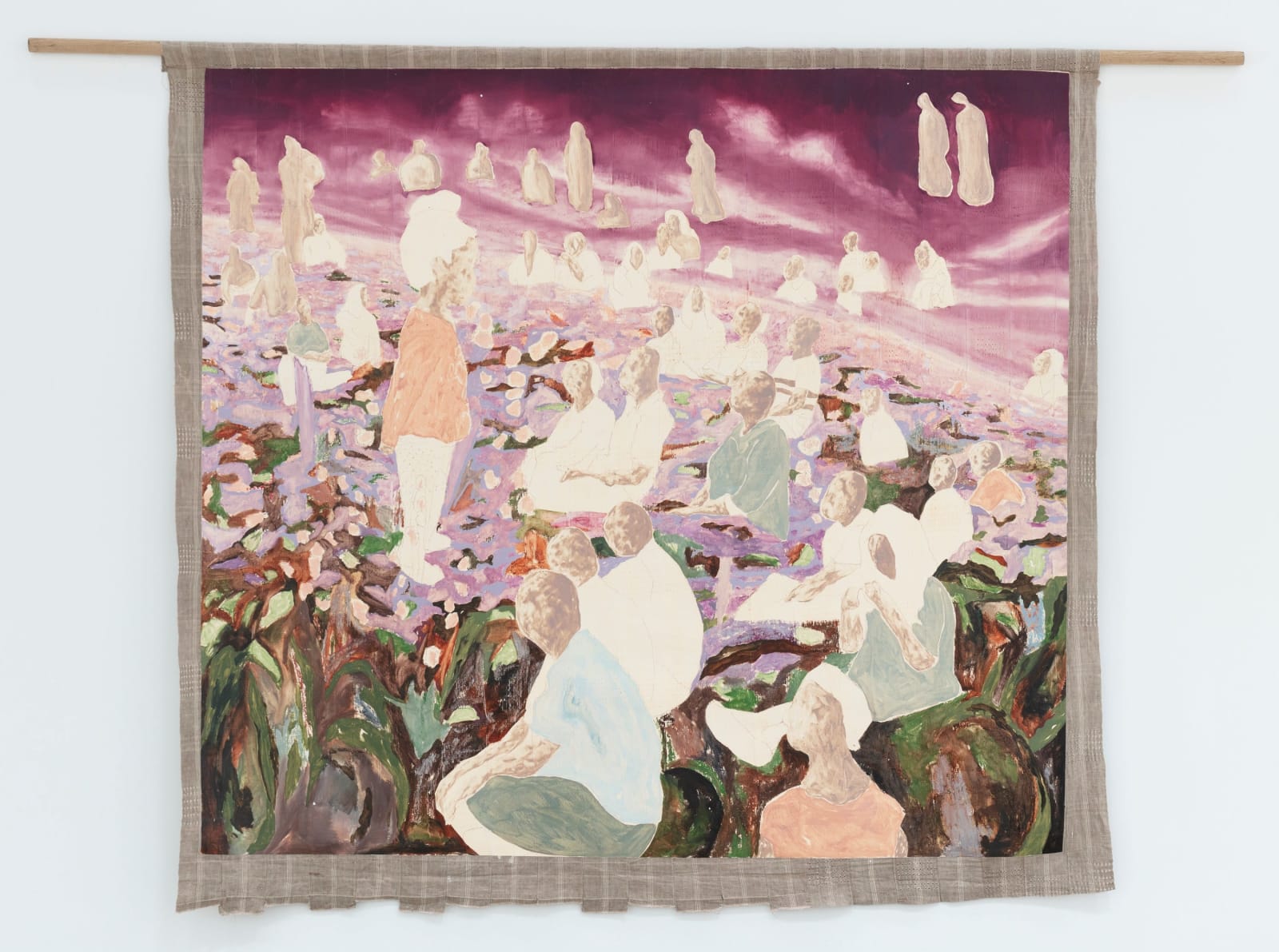
Nengi Omuku b. 1987
The Lighthouse, 2021
oil on sanyan
85 1/8 x 88 5/8 inches, overall
216 x 225 cm
74 1/4 x 82 inches, painting
188.6 x 208.3 cm
216 x 225 cm
74 1/4 x 82 inches, painting
188.6 x 208.3 cm
“The Lighthouse, conceived and created during my residency with the WTO, is about gathering; it is about coming together in stillness and listening to one another. When thinking about the...
“The Lighthouse, conceived and created during my residency with the WTO, is about gathering; it is about coming together in stillness and listening to one another. When thinking about the central character, my inclination was for them to be the embodiment of purity of thought and heart. For this reason, the figure is that of a child.” —Nengi Omuku
Realized while serving as the first artist-in-residence at Geneva’s World Trade Organization, The Lighthouse (2021) exemplifies Nengi Omuku’s distinctive application of oil paint in richly-textured brushstrokes to gessoed sanyan, a tightly-woven and hand-spun material that has helped shape the cultural history of the artist’s native Nigeria. Surrounded by glass walls in a studio in the World Trade Organization’s headquarters—the Centre William Rappard, conceived as a post-World War I effort to foster peaceful conflict resolution and bearing witness to 90 years of international cooperation—Omuku’s artistic process was left unconventionally exposed. The Lighthouse exudes this sense of dislocation—a characteristic theme of Omuku’s oeuvre. Away from the comfort of her home studio in Lagos, Omuku created this enlarged painting of a child surrounded by bodies that dissolve into and emerge from a landscape composed of the artist’s lush palettes. Following the opportunity to see impressionist paintings in Paris and to visit Claude Monet’s garden in Giverny during a previous residency in France, Omuku was particularly attentive to the Swiss landscape upon her arrival to Geneva.
Amid preparations for the 12th Ministerial Conference—the topmost decision-making body of the World Trade Organization regarding multilateral trade agreements—Omuku found as much inspiration from the Genevan flora as she had in Giverny or in Lagos. Praised by The New York Times critic John Vincler for its “impression of beautiful figuration distilled from some ethereal miasma of dreams” following its inclusion in Omuku’s first-ever New York gallery exhibition at Kasmin in 2022, The Lighthouse marks an important progression in Omuku’s attitude toward the tradition of landscape painting. Recalling her early training as a florist and horticulturist under her mother, Omuku introduces an autobiographical element to her practice with The Lighthouse, overcoming her previous hesitation to incorporate such subject matter in her paintings.
Realized while serving as the first artist-in-residence at Geneva’s World Trade Organization, The Lighthouse (2021) exemplifies Nengi Omuku’s distinctive application of oil paint in richly-textured brushstrokes to gessoed sanyan, a tightly-woven and hand-spun material that has helped shape the cultural history of the artist’s native Nigeria. Surrounded by glass walls in a studio in the World Trade Organization’s headquarters—the Centre William Rappard, conceived as a post-World War I effort to foster peaceful conflict resolution and bearing witness to 90 years of international cooperation—Omuku’s artistic process was left unconventionally exposed. The Lighthouse exudes this sense of dislocation—a characteristic theme of Omuku’s oeuvre. Away from the comfort of her home studio in Lagos, Omuku created this enlarged painting of a child surrounded by bodies that dissolve into and emerge from a landscape composed of the artist’s lush palettes. Following the opportunity to see impressionist paintings in Paris and to visit Claude Monet’s garden in Giverny during a previous residency in France, Omuku was particularly attentive to the Swiss landscape upon her arrival to Geneva.
Amid preparations for the 12th Ministerial Conference—the topmost decision-making body of the World Trade Organization regarding multilateral trade agreements—Omuku found as much inspiration from the Genevan flora as she had in Giverny or in Lagos. Praised by The New York Times critic John Vincler for its “impression of beautiful figuration distilled from some ethereal miasma of dreams” following its inclusion in Omuku’s first-ever New York gallery exhibition at Kasmin in 2022, The Lighthouse marks an important progression in Omuku’s attitude toward the tradition of landscape painting. Recalling her early training as a florist and horticulturist under her mother, Omuku introduces an autobiographical element to her practice with The Lighthouse, overcoming her previous hesitation to incorporate such subject matter in her paintings.
